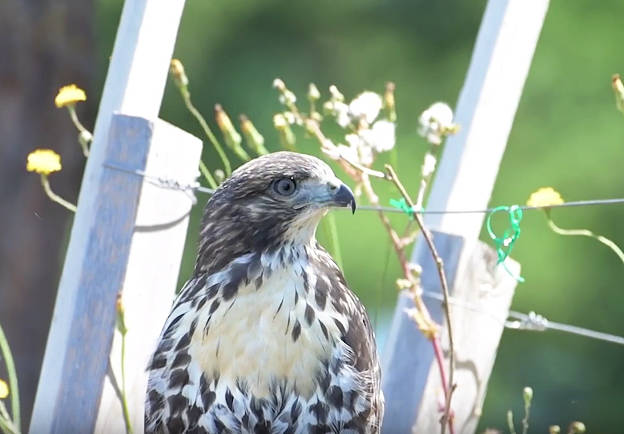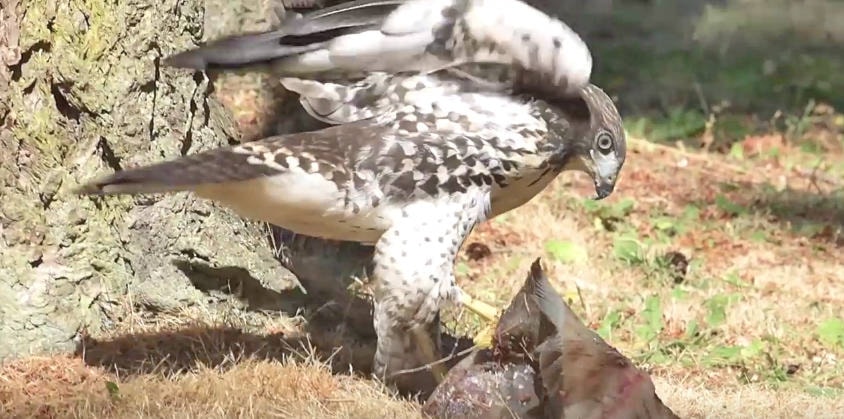A hawk that survived growing up in an eagle’s nest in Sidney continues to astound bird experts — especially for its sheer pluck.
A red-tailed hawk chick was apparently taken by a pair of eagles back in late May or early June, and dropped in a large nest near Somerset Road, close to Roberts Bay in Sidney. Observers saw two hawklets in the nest — but only one survived. A few experts figured at the time the hawks were taken as a food source for the young eaglets.
https://www.youtube.com/watch?v=hoXuP_9c6Rg
But the male hawk, or Spunky, as he’s become known to most people who have been watching his amazing survival, was never eaten. (He’s also known by a few other names, like Stephen Colbert, Hawklet and Little Big Bird.) He fledged from the nest before his adoptive sisters and has been flying weeks prior to the young eagles and shows signs of normal hawk behaviour — aided by some well-meaning human neighbours.
“I thought his chances were zilch at first,” said Dave Hancock, founder of the Hancock Wildlife Foundation which monitors eagles via cameras placed around the province.
“But I didn’t say so at first. You have to be optimistic. And you can, because he does new things every day!”
Hancock said observers have seen the hawk fly around the entire Roberts Bay area, and even soar with the family of eagles closer to the airport land. That bodes will for the hawk, Hancock said, as it exposes him to some of the things hawks normally do.
https://youtu.be/Uq_Cm8C01cs
However, says Dr. David Bird, Emeritus Professor of Wildlife Biology, McGill University, it was the hawk’s attitude that helped him survive.
“It was the attitude of the little hawk, in between its eagle ‘siblings’,” he explained, “especially its aggression in getting food from the other eagles.”
Bird added the abundance of food brought by the parent eagles also played a role. Had the eaglets been starving, or bored, they could have easily dispatched the hawk. And thanks to the fact hawks grow faster than eagles, it was able to fly out of the nest first — coming back for food, which at times it took right out from under the eagles’ beaks.
Bird said the hawk is at the stage now where it’s trying to forage for food. It’s been seen pecking at seaweed on nearby beaches — behaviour of eagles, not generally of hawks, he said. For the hawk to survive in the long-term, Bird continued, it needs to forage for mice, rats, small rabbits and even carrion — and stay away from other eagles. He explained that once predators like eagles and hawks leave the nest, it’s almost an every-bird-for-itself situation.
“They effectively don’t like each other.”
How the hawk survives after the eagles have all left and migrated north, will be a key factor.
Hancock said hawks either stay in a general area or move around. He said there have been hawks in this area from as far away as Puget Sound and Alberta. He added some food hawks typically eat has been left in the open for it to sample, in the hopes of getting it used to that sort of prey.
Bird added it’s a shame the hawk was never banded or had a tracker attached to it, as from a scientific level, seeing how the story goes — and potentially ends — would be fascinating.
Both Bird and Hancock agree that the hawk’s survival this long has been unique — especially how it’s been so public and visible for interested humans.
“It’s a wonder to me, as a biologist, that he’s made it this far,” Hancock said.
“It’s a wonderful story,” added Bird, who lives in Sidney. “We may never see something like this happen again soon … and it’s right in my back yard.”
Both Bird and Hancock say the hawk seems to have also adopted the neighbourhood, showing little fear of people, but not letting them near him — which is a good thing. Some people have suggested it be captured and habituated to other hawks.
But Bird said that’s not going to happen as long as the hawk is healthy and has a fighting chance — something it’s already shown to have all on its own.
There is now talk of creating a movie or documentary about the hawk, especially with the abundance of photos and video out there.
Bird said the whole thing has created new stories for people in the Sidney neighbourhood — stories they hope to share early next month, during a planned gathering in that part of the community.
By then, Bird said, it’s likely the hawk will be long gone. But the experience and the stories remain.




